To stay warm and safe while hiking in extreme cold, begin with strategic layering. Use a moisture-wicking base layer, an insulating mid-layer of fleece or down, and a waterproof outer shell. Opt for fabrics like wool or synthetic materials for their heat-retaining and moisture-managing properties. Protect extremities by using layers for socks, gloves, and a warm hat. Equip yourself with insulated boots and essential gear like traction devices for icy paths. Regularly monitor weather conditions and adhere to your pre-planned itinerary for safety. Wise preparation and diligent awareness are your best defenses against the cold's challenges. Learn about essential gear and strategies next.
Key Takeaways
- Layer clothing with moisture-wicking, insulating, and waterproof materials to maintain warmth and dryness.
- Protect extremities with a dual-layer sock system, hat, and layered gloves to prevent frostbite.
- Stay vigilant about weather conditions and plan routes accordingly to avoid sudden changes and hazards.
- Maintain hydration and energy with regular water intake, warm beverages, and high-energy snacks.
- Recognize hypothermia symptoms early and act quickly to warm affected individuals and prevent severe conditions.
Importance of Layering
Layering is a fundamental strategy for maintaining warmth and safety during winter hiking, as it effectively manages body heat and moisture. Employing strategic layering is essential for temperature regulation, allowing hikers to adjust to fluctuating environmental conditions and varying activity levels. The key lies in utilizing the three primary layers: base, insulating, and outer.
The base layer is significant for moisture management, drawing perspiration away from the skin to prevent chilling. This layer should be snug and crafted from moisture-wicking materials, ensuring dryness and comfort.
The insulating layer, positioned above the base layer, is responsible for trapping heat. Materials such as fleece or down are ideal for this purpose, providing important warmth without adding excessive weight.
The outer layer must serve as a barrier against wind and precipitation. Waterproof and breathable fabrics like GORE-TEX are recommended, as they protect against harsh weather while allowing moisture to escape.
Adapting these layering strategies according to exertion levels and changing weather conditions is essential. By adjusting layers, hikers can maintain best comfort, avoiding overheating or moisture buildup, which could lead to potential risks such as hypothermia.
Hence, mastering layering techniques is indispensable for safe winter hiking.
Choosing the Right Fabrics
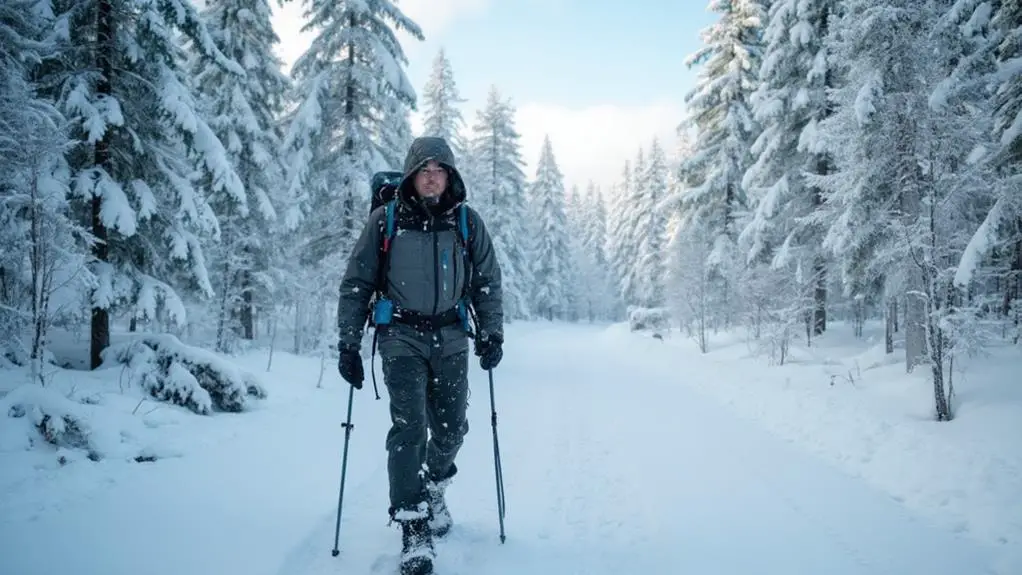
Selecting the appropriate fabrics is vital for maintaining warmth and comfort during winter hikes.
Wool and fleece serve as excellent base and mid-layer materials due to their superior insulation and moisture-wicking capabilities, ensuring that hikers stay warm and dry.
For outer layers, materials like nylon and polyester provide essential water resistance and windproofing, while synthetic insulation offers reliability in wet conditions, making them indispensable for extreme cold environments.
Optimal Insulation Materials
Choosing the right fabrics for insulation is essential when hiking in extreme cold conditions, as the materials directly impact both warmth and safety. Wool benefits are significant; it retains warmth even when wet, making it perfect for base layers and socks. This natural fiber provides excellent insulation and breathability, ensuring comfort during strenuous activities. While down insulation offers unmatched warmth-to-weight ratios, it is less effective in damp conditions. Consequently, down alternatives such as synthetic insulation are recommended. Synthetic materials, like polyester, maintain their insulating properties when wet and are well-suited for jackets and sleeping bags in unpredictable weather.
Below is a comparison of key insulation materials:
| Material | Strengths | Limitations |
|---|---|---|
| Wool | Warm when wet, breathable, natural fiber | Heavier, can be bulkier |
| Down | Lightweight, compressible, high warmth | Loses insulation when damp |
| Synthetic | Retains warmth when wet, durable | Less compressible than down |
| Fleece | Breathable, lightweight, moisture-wicking | Less wind-resistant |
| Nylon/Polyester | Durable, water-resistant, protective | Less breathable, can trap moisture |
Fleece, another practical choice, serves as a mid-layer due to its ability to wick moisture and insulate. For outer layers, durable nylon and polyester fabrics are ideal, offering protection against wind and snow.
Moisture-Wicking Fabric Benefits
When hiking in extreme cold, the choice of insulation material is only part of the equation; moisture-wicking fabrics play a vital role in maintaining warmth and safety. Fabric technology, particularly in the area of moisture management, guarantees that sweat is effectively pulled away from the skin. This is essential for regulating body temperature and preventing the chilling effect that can occur when temperatures plummet.
Moisture-wicking fabrics are typically crafted from synthetic materials such as polyester or nylon. These fabrics dry rapidly, minimizing the risk of dampness that can contribute to hypothermia. In cold conditions, the baselayer is where moisture-wicking properties are most important. They not only trap air for insulation but also maintain skin dryness, enhancing warmth retention.
Wool is another effective option, capable of absorbing up to 30% of its weight in moisture without feeling wet, thereby preserving warmth even when slightly damp.
Selecting the right moisture-wicking fabric can greatly improve comfort and safety. It allows for greater freedom of movement and reduces the risk of frostbite by keeping exposed skin dry. This strategic choice in apparel can make a considerable difference in your hiking experience.
Protecting Your Extremities
Understanding how to protect your extremities is essential when hiking in extreme cold conditions, where even brief exposure can lead to discomfort or serious injury.
Extremity protection begins with cold prevention strategies tailored to keep hands, feet, and head warm. Prioritizing warmth for these areas is critical, as they are typically the first to experience cold.
For your feet, employ a dual-layer sock system: start with liner socks to wick away moisture, followed by thick wool socks for insulation. Pair these with insulated, waterproof boots that provide adequate traction and space for thicker socks.
Hands require a similar approach. Utilize a glove system comprising liner gloves for moisture management and mid-weight fleece gloves for added warmth. Consider using hand warmers for supplemental heat during prolonged exposure to cold conditions.
In addition to hands and feet, wearing a hat that covers your ears is important, as the head can lose up to 30% of body heat. Foot warmers can further safeguard against cold.
Regularly check extremities for frostbite symptoms—such as numbness or discoloration—and respond immediately to prevent severe injury. By adhering to these strategies, you can guarantee effective extremity protection and cold prevention.
Essential Winter Gear
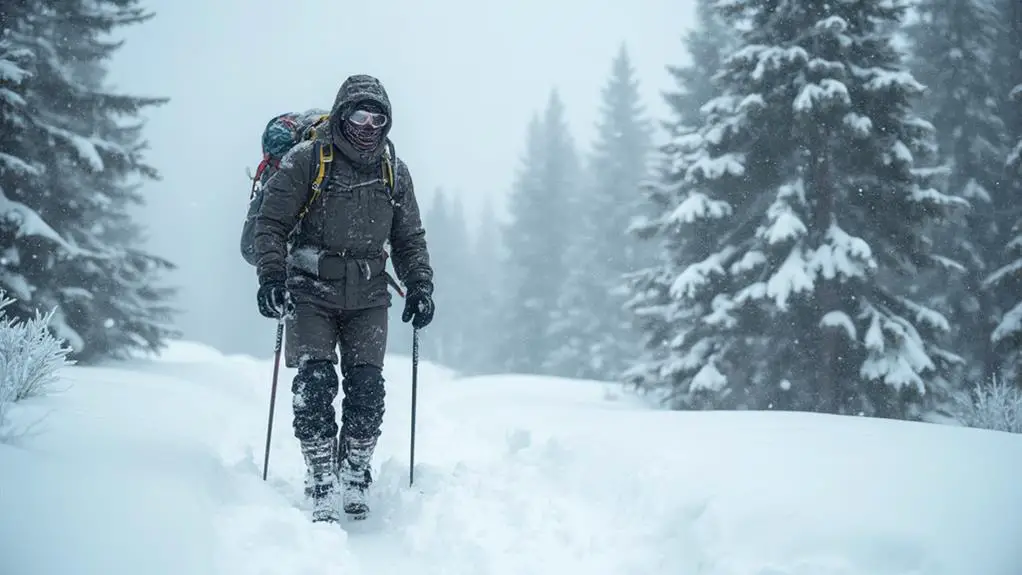
Mastering the art of layering is vital for maintaining ideal body temperature in extreme cold conditions, beginning with a moisture-wicking base layer, followed by an insulating mid-layer, and completed with a waterproof outer shell.
Equally important is assembling a checklist of essential accessories, including insulated waterproof boots, a warm hat, gloves or mittens, and moisture-wicking socks, to guarantee thorough protection from the elements.
Additionally, trekkers should not overlook the necessity of carrying traction devices and trekking poles to navigate icy terrains safely, alongside the Ten Essentials for emergency preparedness.
Layering Techniques Mastery
In the domain of winter hiking, mastering layering techniques is vital for maintaining warmth and safety in extreme cold conditions. A strategic approach to layering strategies involves three essential components: the base layer, mid-layer, and outer layer.
The base layer serves as the foundation and is designed to wick moisture away from the skin to keep you dry. Opt for synthetic or wool materials, as they outperform cotton, which retains moisture and can lead to dangerous heat loss.
The mid-layer plays an important role in insulation, using materials like fleece or down jackets to trap body heat while allowing excess moisture to escape. This balance guarantees warmth without overheating or dampness.
The outer layer, typically crafted from breathable, waterproof materials such as GORE-TEX, guards against wind and moisture while enabling sweat vapor to escape, thereby maintaining comfort in variable conditions.
Proper layering offers the flexibility to adjust clothing according to activity levels and temperature changes. To implement these strategies effectively, consider the following key points:
- Base Layer: Choose synthetic or wool.
- Mid-Layer: Use fleece or down.
- Outer Layer: Confirm breathability and waterproof properties.
- Adjustability: Adapt layers to activity and temperature.
- Avoid Cotton: Prevent heat loss from retained moisture.
Crucial Accessories Checklist
While layering is fundamental to staying warm during winter hikes, it is equally important to equip yourself with the right accessories to guarantee thorough protection against the elements. These hiking accessories are vital components of winter preparedness, each designed to combat specific challenges posed by extreme cold conditions.
First, a wool or synthetic hat is indispensable, as it helps retain body heat, preventing up to 30% of heat loss that occurs through an unprotected head.
In addition, insulated and waterproof gloves or mittens are necessary; mittens often provide superior warmth by allowing fingers to share heat. Complementing these, a neck gaiter or scarf crafted from breathable materials shields the neck and face from biting winds and potential frostbite, while ensuring comfort.
Foot protection is paramount; moisture-wicking socks are essential for keeping feet dry. Consider layering with a thin liner sock beneath a thicker wool sock to maximize warmth.
Additionally, insulated and waterproof boots with excellent traction are essential to prevent frostbite and maintain stability on icy terrains.
Monitoring Weather Conditions
A vital aspect of preparing for a hike in extreme cold conditions is diligently monitoring weather conditions, as this can markedly impact both safety and enjoyment.
Utilizing reliable weather apps such as NOAA and Mountain Forecast provides a thorough view of temperature, wind chill, and precipitation forecasts. These tools are invaluable for anticipating and preparing for the elements you're likely to encounter.
For those venturing into mountainous terrain, it is imperative to check avalanche forecasts, particularly following heavy snowfall, to evaluate the risk of avalanches along your intended route.
Continuous vigilance of weather conditions during your hike is essential, as sudden drops in temperature or unexpected storms may necessitate immediate changes to your plans.
Additionally, being mindful of shortened daylight hours in winter is important; an earlier turnaround time is advisable to avoid the hazards of hiking in darkness.
To promote preparedness, consider the following steps:
- Check multiple weather apps for updated forecasts.
- Monitor avalanche forecasts in mountainous areas.
- Reassess conditions during the hike and adjust plans as needed.
- Plan for shorter daylight by setting early turnaround times.
- Stay informed through local ranger stations for trail updates.
These practices promote a safe and enjoyable hiking experience.
Selecting Safe Trails
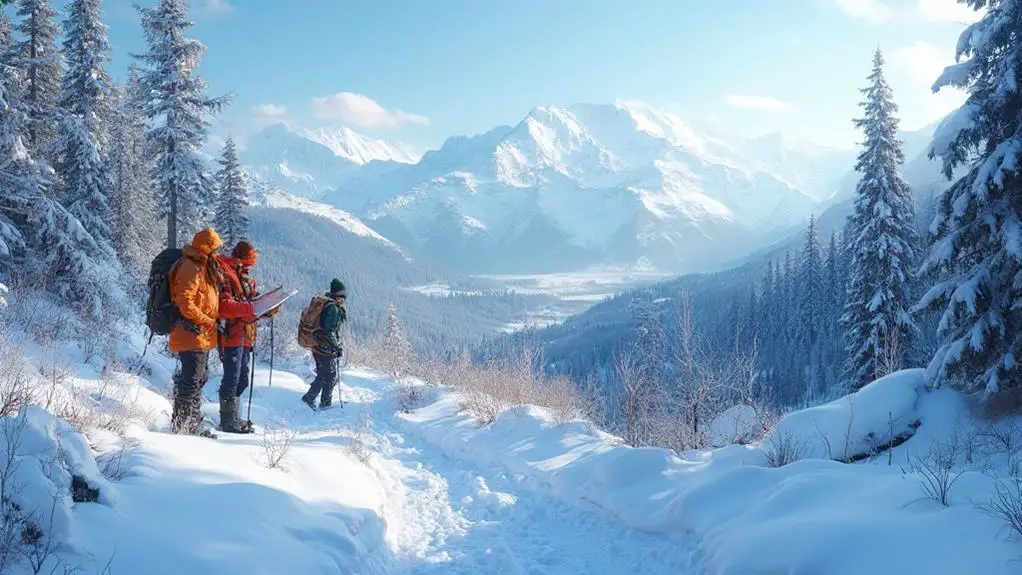
When selecting safe trails for hiking in extreme cold conditions, it is essential to assess trail conditions meticulously and choose shorter routes to mitigate potential hazards.
Opting for well-marked and familiar paths minimizes the risk of getting lost, particularly when snow obscures trail markers, while shorter distances guarantee a quicker retreat to safety if weather conditions worsen.
Additionally, always verify avalanche warnings and current trail conditions, as these factors are critical for maintaining safety during winter hikes.
Assess Trail Conditions
Before commencing on a hike in extreme cold conditions, it is imperative to meticulously evaluate trail conditions to guarantee safety. Conduct a thorough trail examination using resources such as AllTrails to determine if the selected path is suitable for winter hiking.
Snow and ice are common winter hazards that can greatly increase the difficulty and danger of a trail. Consequently, a careful evaluation is essential to avoid precarious situations.
Key considerations for evaluating trail conditions include:
- Trail Maintenance: Opt for trails that are well-maintained to reduce risks associated with ice and snow.
- Terrain Type: Avoid trails with steep inclines and rugged terrain, as icy conditions can exacerbate the risk of falls and injuries.
- Avalanche Risk: For trails in mountainous regions, check avalanche forecasts, especially after recent heavy snowfall, to prevent exposure to life-threatening scenarios.
- Accessibility Issues: Identify potential obstacles such as snow bridges or fallen trees that may impede progress or increase hazards.
- Safety Resources: Utilize online platforms and local advisories to stay updated on current trail conditions and any reported dangers.
Choose Shorter Routes
Having thoroughly assessed trail conditions, the next consideration is selecting a trail that guarantees both safety and manageability in extreme cold.
Trail selection plays a significant role in ensuring a safe hiking experience. Prioritize shorter, well-marked trails to minimize exposure to harsh weather, reducing the chances of frostbite and hypothermia. A shorter hike duration allows for better control over body temperature and energy conservation, essential factors when maneuvering through extreme cold environments.
Opt for trails with minimal elevation gain. Rugged terrains not only increase the risk of injuries but also complicate the ability to return swiftly to safety. Steep inclines can become treacherous under icy or snow-covered conditions, making flat or gently sloped paths more desirable.
Additionally, choosing trails that are easily accessible and familiar enhances safety. Familiarity with the route aids in quicker exit decisions and awareness of potential hazards.
Before setting out, always verify the current trail conditions. Even short routes can pose significant threats if ice or snow cover the paths.
Ultimately, the key to safe hiking in extreme cold lies in careful trail selection and keeping the hike duration manageable, ensuring a safe and enjoyable adventure.
Hydration and Nutrition Tips

In the domain of extreme cold-weather hiking, maintaining ideal hydration and nutrition is paramount to safety and performance. Effective hydration strategies are essential, as dehydration can occur even in cold climates. It is important to drink water regularly to sustain hydration levels.
Utilizing a thermos to carry warm beverages such as tea or soup can simultaneously provide hydration and help maintain core body temperature. Monitoring your fluid intake is significant, as physical exertion in cold conditions demands increased hydration.
Equally important is the selection of appropriate snack options to guarantee adequate energy levels are maintained throughout the hike. High-energy snacks like nuts, energy bars, and dried fruits provide quick fuel, making them ideal choices for cold-weather hikes.
These snacks are compact, easy to carry, and deliver necessary nutrients efficiently. Eating meals rich in carbohydrates and fats before and during your hike can offer sustained energy, supporting endurance in extreme conditions.
Here are some key points to take into account:
- Drink water regularly to avoid dehydration.
- Carry warm beverages in a thermos for additional hydration.
- Choose high-energy snacks for quick fuel.
- Consume meals rich in carbohydrates and fats for sustained energy.
- Monitor your food and fluid intake diligently.
Staying Aware of Hypothermia
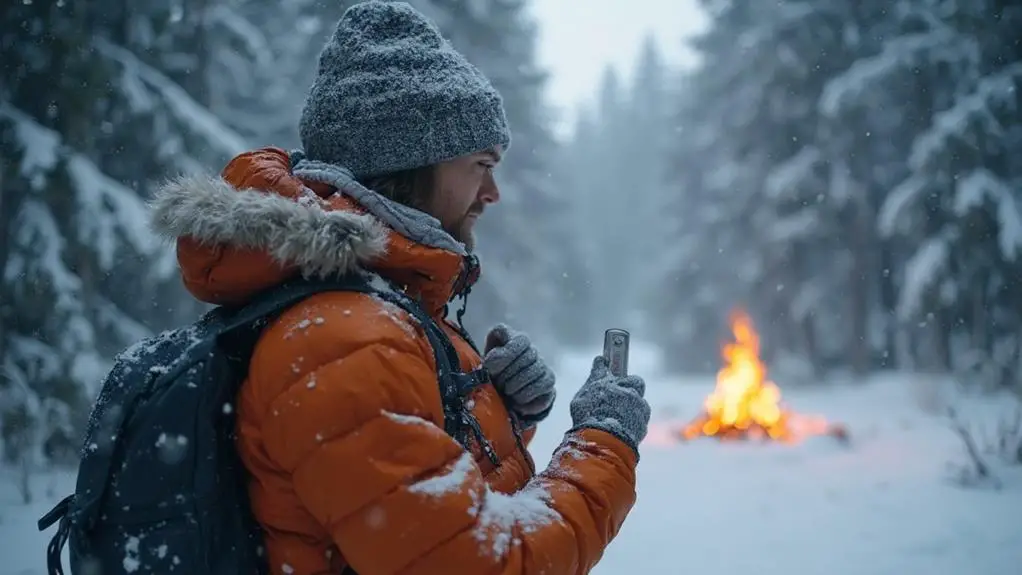
Hypothermia is a vital condition that can have severe consequences if not quickly addressed during cold-weather hikes. When body temperature falls below 95°F (35°C), hikers may experience hypothermia symptoms such as shivering, confusion, and slurred speech. Recognizing these early signs, including intense shivering and fatigue, is essential in preventing the condition from worsening.
Prolonged exposure to cold, especially when combined with wetness, greatly increases the risk, emphasizing the importance of staying dry and warm.
Prevention strategies are key in mitigating hypothermia risks. Start by layering clothing appropriately, allowing for adjustments based on exertion levels and environmental conditions. This helps maintain a stable body temperature.
Wind chill can deceptively lower apparent temperatures, so always check forecasts for wind chill factors before starting on a hike. Additionally, monitor your body's responses and be vigilant about any developing hypothermia symptoms.
Should symptoms arise, act promptly by seeking shelter, adding dry layers, and consuming warm fluids if possible. By proactively employing these prevention strategies, hikers can safeguard against hypothermia, ensuring a safer and more enjoyable outdoor experience in extreme cold conditions.
Planning Your Route
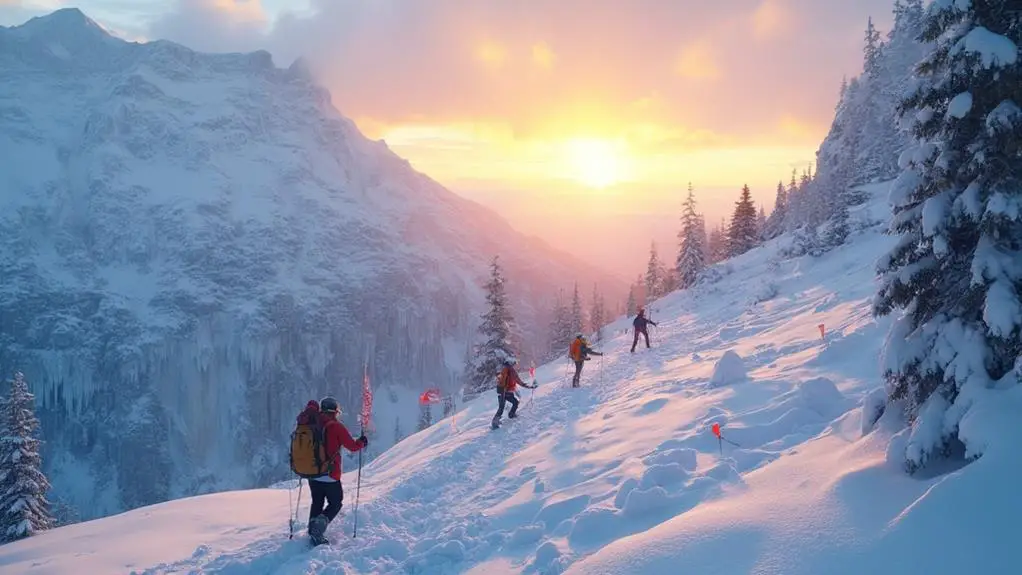
A successful hike in extreme cold conditions begins with meticulous planning of your route. The process of trail mapping and route evaluation is essential to guarantee both safety and enjoyment.
Start by thoroughly researching your chosen path, taking into account trail length, elevation gain, and potential hazards such as icy surfaces or avalanche-prone areas. Opting for shorter, well-marked trails that you're familiar with can minimize risks and ease navigation in adverse weather.
To enhance safety, keep the following considerations in mind:
- Research Trail Conditions: Utilize reliable sources like AllTrails or local ranger stations for the latest updates on trail conditions and weather-related modifications.
- Plan an Itinerary: Document your route, estimated hiking time, and expected return time, and share it with a trusted individual.
- Daylight Optimization: Choose a start time that maximizes daylight hours and helps avoid the dangers of hiking in the dark.
- Set a Turnaround Time: Establish a strict turnaround time to prevent being caught in hazardous conditions as night approaches.
- Evaluate Potential Hazards: Pay attention to natural risks and adjust your plans accordingly to maintain safety.
Communicating Your Plans

Effective communication of your hiking plans is paramount when venturing into extreme cold conditions. Itinerary sharing is a critical step that guarantees your safety. Before starting your hike, provide a trusted friend or family member with a detailed itinerary outlining your planned route, expected return time, and any potential detours. This guarantees that someone is always aware of your whereabouts, serving as a crucial reference point in case of unforeseen circumstances.
Additionally, leaving a copy of your itinerary in your parked vehicle acts as an accessible reference for emergency contacts and rescue personnel. This strategic measure can be invaluable should you fail to return as scheduled, enabling a more efficient search and rescue operation.
For those hiking solo, leveraging technology such as GPS tracking apps can enhance safety. These applications allow real-time location monitoring, giving your emergency contacts the ability to track your progress and respond swiftly if necessary.
Moreover, establish a regular check-in schedule with someone at home, updating them on your progress and any itinerary changes. This ongoing communication provides reassurance and allows for timely assistance should conditions necessitate a deviation from your original plans.
Using Traction Devices
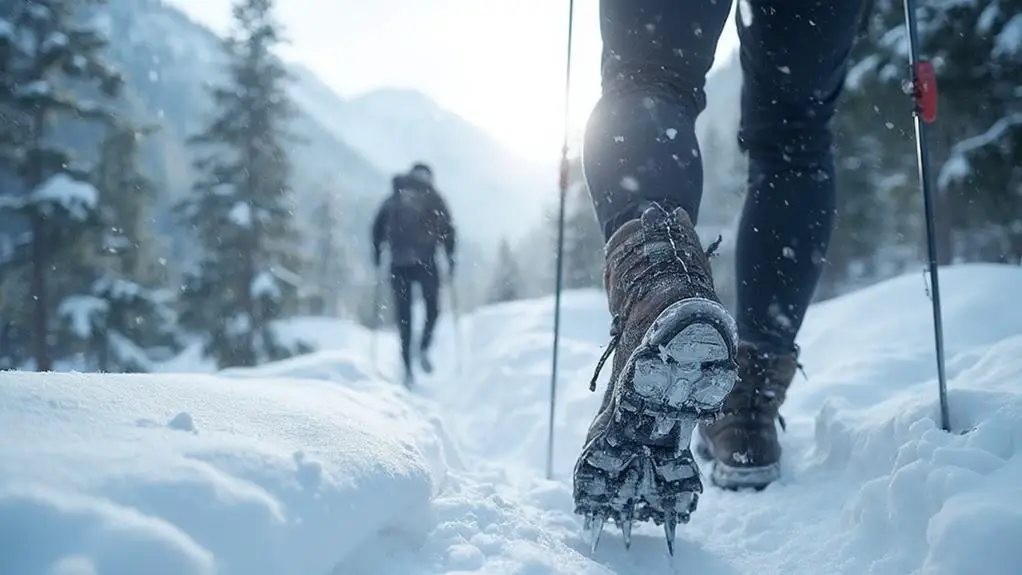
In the domain of winter hiking, utilizing traction devices is fundamental for guaranteeing stability and safety on icy or snowy trails.
Traction device types such as microspikes and snowshoes are essential tools to enhance grip and prevent hazardous slips and falls. Microspikes, characterized by their lightweight nature and ease of attachment to hiking boots, offer excellent traction on icy trails through their robust metal spikes.
Conversely, snowshoes are designed to distribute weight across a larger surface area, preventing hikers from sinking into soft, powdery snow and facilitating smoother navigation across winter landscapes.
Selecting the appropriate traction device based on trail conditions is critical. Microspikes are ideal for hard-packed snow and icy terrain, while snowshoes excel in deeper, softer snow environments.
Regular traction device maintenance is paramount; inspecting for wear and tear confirms that all components, such as spikes and straps, remain intact and functional. This maintenance is necessary for maintaining safety and performance during winter outings.
Consider these practical tips:
- Evaluate trail conditions to determine the appropriate traction device type.
- Attach microspikes securely to avoid accidental detachment.
- Adjust snowshoes for fit to enhance comfort and effectiveness.
- Inspect devices regularly for signs of wear.
- Replace damaged spikes or straps immediately for maximum safety.
Managing Cold Exposure
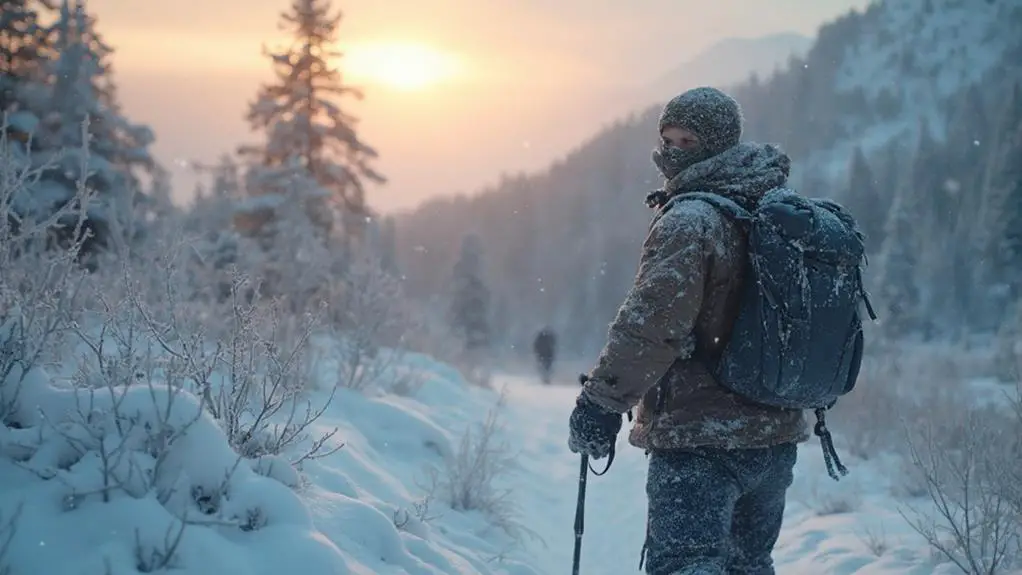
While traction devices safeguard hikers from slips and falls, managing cold exposure is equally essential to guarantee overall safety and well-being during winter hikes. Prolonged cold exposure can result in hypothermia, characterized by shivering, confusion, and slurred speech. Recognizing these symptoms early is a vital safety measure, as timely intervention can prevent severe outcomes.
Equally concerning is frostbite, a condition where skin and tissues freeze, often affecting extremities like fingers and toes, which may lead to permanent damage if left unaddressed.
To protect against these risks, prioritize keeping hands and feet warm. Utilize a layered glove system with liner gloves paired with hand warmers, and adopt a two-sock approach: liner socks beneath thicker wool socks for best insulation.
Adjust clothing layers based on activity levels to avoid overheating and subsequent sweating, which can exacerbate cold exposure.
During breaks, a thermos filled with hot beverages such as tea or soup can provide vital warmth and hydration, aiding in maintaining core body temperature.
Through these practical safety measures, hikers can effectively manage cold exposure, ensuring a safer and more enjoyable winter hiking experience.
Author Background
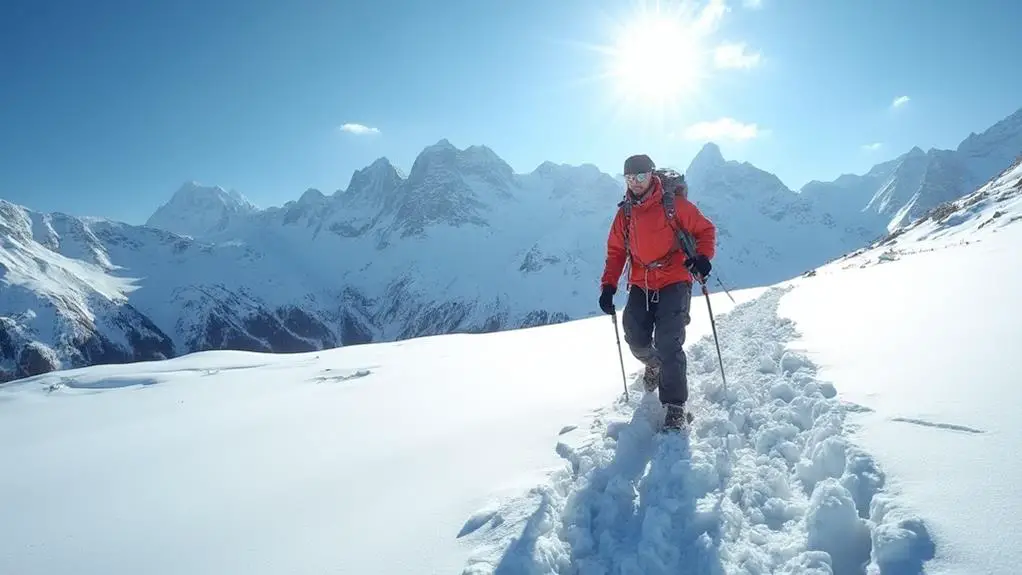
Rebecca Ross, a seasoned mountaineer and outdoor photographer based in the Pacific Northwest, brings a wealth of experience to the domain of winter hiking and mountaineering. Since 2017, she has honed her skills in maneuvering through extreme cold conditions, making her a trusted voice in the outdoor community.
Her mountaineering experiences are complemented by her talent for photography, which has earned her features in prestigious outdoor magazines. These publications not only highlight her technical skills but also her ability to artistically capture the serene yet challenging environments she explores.
Ross's dedication to advancing her mountaineering skills is evident in the scholarships and grants she has received, underscoring her commitment to continuous learning and excellence in the sport.
Her current project, a memoir detailing her climbing expeditions in Georgia, promises to offer insights into her adventurous spirit and the depth of her experiences. Through her writing and social media channels, Ross inspires enthusiasts to pursue outdoor activities with safety and enthusiasm.
- Extensive winter hiking and mountaineering expertise.
- Published works in notable outdoor magazines.
- Scholarships and grants for mountaineering skill development.
- Memoir on climbing expeditions in Georgia.
- Inspires safe enjoyment of winter outdoor activities.
Frequently Asked Questions
How Do You Survive Extreme Cold Camping?
Surviving extreme cold camping necessitates using appropriate cold weather gear, including insulated sleeping bags and moisture-wicking layers. Employ advanced camping techniques such as securing a winter-rated tent and maintaining vigilance for frostbite and hypothermia symptoms.
How to Stay Warm in 0 Degree Weather?
To stay warm in 0-degree weather, employ effective layering techniques with a moisture-wicking base, insulating mid-layer, and protective outerwear. Essential gear includes insulated, waterproof boots, thick socks, hand warmers, and a thermos for added warmth and hydration.
How Do You Prevent Frostbite When Hiking?
Preventing frostbite while hiking involves recognizing frostbite symptoms such as numbness, tingling, and discoloration. Implement layered clothing, protect extremities, and maintain circulation. Frostbite treatment necessitates immediate rewarming and medical attention to mitigate severe tissue damage.
Is It Safe to Walk in Extreme Cold?
Walking in extreme cold can be safe when equipped with appropriate cold weather gear and following essential hiking safety tips. Prioritize layered clothing, monitor weather conditions, choose manageable trails, and remain vigilant for signs of hypothermia and frostbite.
Conclusion
In extreme cold conditions, effective preparation is paramount for ensuring warmth and safety during hiking. Mastery of layering techniques, selection of appropriate fabrics, and safeguarding extremities are vital components. Equipping oneself with essential winter gear, monitoring weather developments, and communicating plans enhance preparedness. Employing traction devices and managing cold exposure further mitigate risks. By adhering to these strategies, hikers can greatly enhance their resilience and safety, enabling a more secure and controlled outdoor experience in harsh environments.